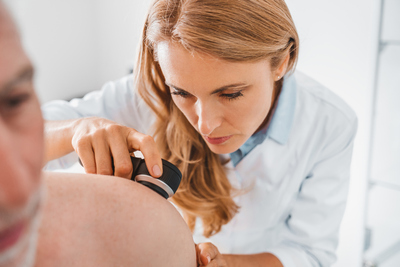Anyone Can Get Skin Cancer
It’s scary if your dermatologist utters the words “skin cancer.” Before you panic, get to know the most common types of skin cancer and how to keep your skin safe. People who catch skin cancer early have the best outcomes, so don’t be cavalier about getting an annual skin check.
No One is Immune
 Skin cancer is the most common cancer in the US, affecting one in five Americans in their lifetime, according to the American Academy of Dermatology Association. And anyone can get it.
Skin cancer is the most common cancer in the US, affecting one in five Americans in their lifetime, according to the American Academy of Dermatology Association. And anyone can get it.
In June, pop star Kevin Jonas revealed on Instagram he was recently diagnosed with basal cell carcinoma, the most common and curable type of skin cancer. While waiting at the hospital to have the mole removed from his hairline, he urged his 90,000-plus social media fans to “Make sure to get those moles checked, people.”
We applaud him for using his platform to help people stay healthy. Dr. Jason H. Miller, a board-certified dermatologist and Medical Director at Schweiger Dermatology Group in New Jersey, adds, “Early detection is key to find skin cancers when they are the most treatable. By getting your annual skin check, cancers — or even precursor lesions — can be identified before they have a chance to progress.” He also notes that finding skin cancer early can lead to smaller scars after a procedure.
Protect Yourself
Skin cancer forms because of extended UV ray exposure after years of frequent sunning or indoor tanning. Yes, most of us have overdone it in the sun at one point or another, but it’s never too late to follow the cardinal rules for healthy and safe sun exposure.
Guard your skin from UV rays by wearing UPF clothing and hats, seeking shade and staying far away from tanning beds. And don’t go out without using a broad-spectrum, water-resistant sunscreen with an SPF of 30 or higher. Although higher SPFs block more UV rays than lower SPFs, the American Academy of Dermatology Association advises that their protection lasts about the same amount of time. Make sure to reapply sunscreen every two hours for maximum impact.
Be a Mole Detective
Do your own skin checks between annual appointments and know what you’re looking for. Basal cell carcinoma often appears as a flesh-colored round growth, a pearl-like bump or a pinkish patch of skin on the head, neck, arms, chest, abdomen, back or legs. Contact your dermatologist immediately if you see moles that change in shape or size, bleed or itch.
Even if you don’t spot anything suspicious, get an expert’s eye on your skin every year.
Call (844) DERM-DOC to schedule an appointment today or book your appointment online with one of our dermatology providers.
